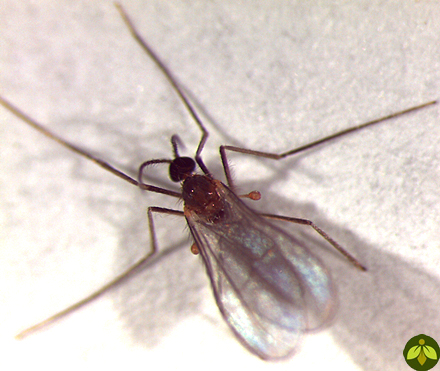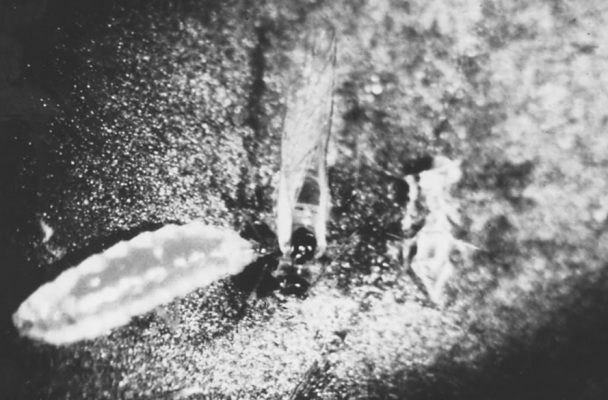General

Aphidoletes aphidimyza is often called the aphid midge. This is because in their larval stage, they will kill and eat more than 60 species of aphids. The adults are small, mosquito-like flies, but are harmless to humans. The larvae are bright orange (sometimes reddish), legless maggots that scoot along the leaves of infested plants, killing and eating aphids. Larvae grow to about 3 mm in length. The eggs are oval, orange, and tiny, measuring 0.1 x 0.3 mm.
Life-history
After emerging from her pupal case, adult females will find a spider web to land on, where she waits for a male to mate with. She will then fly off and lay around 250 eggs among aphid colonies. If there are no spider webs in the greenhouse, many growers make “love shacks” for them that have stretched cotton to mimic a spider web, although studies have shown that actual spider webs result in more use and more successful mating. Ask a Beneficial Insectary IPM Specialist for more details.

The larvae bite the knees of aphids and inject a toxin to paralyze them. They then go to the body of the aphid and suck the juices out. If there is a high concentration of aphids, the larvae will paralyze more aphids than they eat, killing them. They are best used as a cleanup after aphid outbreaks occur, not as a preventative. In the greenhouse, larvae live for about a week before dropping into the soil to pupate. Pupation takes one to two weeks. Once emerged, adults live approximately two weeks, although most of the female’s eggs are laid in the first couple of days. Outdoors, the timing of their life stages is even more variable. The conditions for optimum performance are between 64-77°F with a relative humidity of at least 70%. Note that these are optimum conditions and not necessarily a prerequisite of successful implementation. Significantly cooler or warmer temperatures and/or lower humidity may hamper reproduction and development.
Benefits
One of the biggest benefits of Aphidoletes is they are not picky about the species of aphid they eat. This gives them an advantage over the parasitoid wasps. They’ll also use aphid banker plants, like Aphidius colemani will, but new plants will have to be added more often. They can decimate the banker plant population very quickly. As previously mentioned, if there is a high concentration of aphids where the larvae are, they will paralyze and kill more aphids than they eat. This makes them great for handling larger infestations. However, one larva only needs seven aphids to complete its lifecycle, so they can become established even with smaller infestations of aphids. They’re also very good at finding aphids in the crop. One study showed that a female can locate one infested plant out of 75 un-infested ones.
Drawbacks
Aphidoletes will go into diapause (a quiescent period of suspended development) if the day length is under 12 hours, or if the temperature is below 40°F. However, since they lay their eggs at dusk, they also need a period of low light in the evenings. This makes supplemental lighting ineffective and renders them useless in fall/winter months. Since they pupate in the soil, it is difficult or impossible to get them to successfully complete their lifecycles in hydroponic systems. Certain food crops such as lettuce may be inappropriate for them since they could pupate on the plant. They are also very sensitive to most insecticides.
Scouting
Adults may be seen flying in the early evenings, or even later at night. Females can sometimes be found on spider webs, often with males flying around them. It’s not unusual to see the larvae underneath the leaves in the crop. Since they are bright orange, they standout very well. Another sign of having Aphidoletes in the crop is finding shriveled aphid bodies, and fewer living aphids.
Advisories
These predators cannot be used during times where the day length is below 12 hours, or any time of the year indoors. They can be used in hydroponic systems, but don’t expect any establishment (multiple generations). Caution should be used on food crops that they may pupate in. If ants are present, be sure that they are controlled before releasing Aphidoletes or aphid parasitoids. Aphids produce honeydew that the ants feed on. Because of this, ants protect them from predators or parasitoids. Also, do not release in combination with Chrysoperla since the lacewing larvae will eat the Aphidoletes larvae.
Usages
Greenhouses, fields, orchards, and gardens are all appropriate for them, so long as the day length is adequate.
Release Rates for Aphidoletes aphidimyza
| Classification | Release Information |
|---|---|
| With aphid colonies present | 0.5 to 1 per square meter |
| Comments | Higher release rates will result in more rapid control. Regular releases are recommended for continuous control! |
Purchase
-
 Aphidoletes aphidimyza – aphid predator (2,000/ 10,000)$71.95 – $358.95
Aphidoletes aphidimyza – aphid predator (2,000/ 10,000)$71.95 – $358.95
